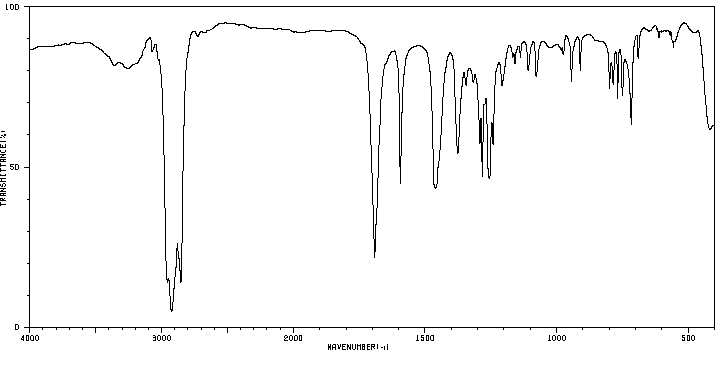2-(4-甲基戊-3-烯基)蒽-9,10-二酮 | 71308-16-2
中文名称
2-(4-甲基戊-3-烯基)蒽-9,10-二酮
中文别名
——
英文名称
2-(4-methyl-3-pentenyl)-anthraquinone
英文别名
2-(4-methylpent-3-enyl)anthraquinone;2-(4-methylpent-3-enyl)anthracene-9,10-dione;2-(4-Methyl-3-pentenyl)anthraquinone
CAS
71308-16-2
化学式
C20H18O2
mdl
——
分子量
290.362
InChiKey
NQVBCGTZRWHVSY-UHFFFAOYSA-N
BEILSTEIN
——
EINECS
——
-
物化性质
-
计算性质
-
ADMET
-
安全信息
-
SDS
-
制备方法与用途
-
上下游信息
-
文献信息
-
表征谱图
-
同类化合物
-
相关功能分类
-
相关结构分类
物化性质
-
沸点:360℃[at 101 325 Pa]
-
密度:1.18[at 20℃]
-
LogP:5.3 at 22℃
计算性质
-
辛醇/水分配系数(LogP):5.8
-
重原子数:22
-
可旋转键数:3
-
环数:3.0
-
sp3杂化的碳原子比例:0.2
-
拓扑面积:34.1
-
氢给体数:0
-
氢受体数:2
SDS
上下游信息
-
上游原料
中文名称 英文名称 CAS号 化学式 分子量 2-溴蒽醌 2-bromoanthracene-9,10-dione 572-83-8 C14H7BrO2 287.112
反应信息
-
作为反应物:描述:2-(4-甲基戊-3-烯基)蒽-9,10-二酮 在 sodium hydroxide 作用下, 以 乙醇 为溶剂, 生成 2-(4-methyl-3-pentenyl)-1,4-dihydro-9,10-dihydroxyanthracene参考文献:名称:CN116003235摘要:公开号:
-
作为产物:描述:2-(4-methyl-3-pentenyl)-1,4,4a,9a-tetrahydroanthraquinone 在 sodium hydroxide 、 氧气 、 二乙胺 作用下, 以 甲苯 、 正丁醇 为溶剂, 反应 1.0h, 生成 2-(4-甲基戊-3-烯基)蒽-9,10-二酮参考文献:名称:Verfahren zur Herstellung von 2-(4-Methyl-3-pentenyl)-anthrachinon摘要:公开号:EP1178032B1
文献信息
-
Organocatalyzed benzannulation for the construction of diverse anthraquinones and tetracenediones作者:Krishna Bahadur Somai Magar、Likai Xia、Yong Rok LeeDOI:10.1039/c5cc00623f日期:——
An efficient one-pot synthesis of anthraquinones and tetracenediones was achieved by
l -proline catalyzed benzannulation of commercially available 1,4-naphthoquinones or 1,4-anthracenedione with a variety of α,β-unsaturated aldehydes in good to excellent yield. -
Discovery and preliminary structure–activity relationship studies on tecomaquinone I and tectol as novel farnesyltransferase and plasmodial inhibitors作者:Melissa M. Cadelis、Marie-Lise Bourguet-Kondracki、Joëlle Dubois、Alexis Valentin、David Barker、Brent R. CoppDOI:10.1016/j.bmc.2016.05.024日期:2016.7farnesyltransferase inhibitory activity in the low micromolar range. A preliminary structure–activity relationship (SAR) study has identified different structural requirements for anti-malarial activity in comparison to FTase activities for these classes of natural products. Our results identify tecomaquinone I as a novel scaffold from which more potent inhibitors of human and parasitic FTase could be developed.生物合成的针对人法呢基转移酶(FTase)的苯并[ c ]亚甲基-7,10-二酮天然产物库的生物学筛选已确定替马醌I(IC 50为0.065± 0.004μM)是已鉴定出的更有效的天然产物抑制剂之一迄今为止。对同一文库针对恶性疟原虫的耐药菌株进行了抗血浆筛选,确定了结构相关的双色酚醇是一种中等活性的生长抑制剂,IC 50为3.44± 0.20μM 。基于苯并[ c]的两个新颖的类似物系列随后合成] chromene-7,10-dione支架,其中一种类似物在低微摩尔范围内表现出法尼基转移酶抑制活性。初步的结构-活性关系(SAR)研究确定了与此类天然产品的FTase活性相比,抗疟疾活性的不同结构要求。我们的研究结果表明tecomaquinone I是一种新型支架,可以从中开发出更有效的人和寄生FTase抑制剂。
-
Remote Arylative Substitution of Alkenes Possessing an Acetoxy Group via β‐Acetoxy Elimination作者:Kazuma Muto、Takaaki Kumagai、Fumitoshi Kakiuchi、Takuya KochiDOI:10.1002/anie.202111396日期:2021.11.8Palladium-catalyzed remote arylative substitution was achieved for the reaction of arylboronic acids with alkenes possessing a distant acetoxy group via nondissociative chain walking and β-acetoxy elimination.
-
LIGAND REGULATED PROTEIN-PROTEIN INTERACTION SYSTEM申请人:St. Anna Kinderkrebsforschung公开号:EP3502130A1公开(公告)日:2019-06-26Disclosed is a ligand regulated protein-protein interaction system based on a lipocalin-fold molecule comprising: (a) a lipocalin-fold molecule (b) a lipocalin-fold ligand with a low molecular weight of 1500 Da or below, and (c) a lipocalin-fold binding interaction partner, wherein the lipocalin-fold molecule can bind to the lipocalin-fold ligand; and wherein the lipocalin-fold molecule bound to the lipocalin-fold ligand binds to the lipocalin-fold binding interaction partner with an affinity which is at least 10-fold higher than the affinity of the lipocalin-fold molecule not bound to the lipocalin-fold ligand, and wherein the lipocalin-fold binding interaction partner is not a naturally occurring protein which has an affinity of <10 µM to any naturally occurring lipocalin-fold molecule in the presence of any lipocalin-fold ligand.
-
2−(4−メチル−3−ペンテニル)−アントラキノンの製造法申请人:——公开号:JP2002053517A公开(公告)日:2002-02-19(57)【要約】\n【課題】 ナフト−1,4−キノンをミルセンと反応させるディールス−アルダー付加及び得られた付加物の酸化からなり、先行技術の欠点を有さず、より高い空時収量及びより高い生成物純度を有する2−(4−メチル−3−ペンテニル)−アントラキノン(IHEAQ)の製造法。\n【解決手段】 酸化段階を、極性溶剤及び無極性溶剤を含有する溶剤混合物中で、無機強塩基及び有機塩基からの組合せ物の存在で、空気又は酸素含有ガスで実施する。
表征谱图
-
氢谱1HNMR
-
质谱MS
-
碳谱13CNMR
-
红外IR
-
拉曼Raman
-
峰位数据
-
峰位匹配
-
表征信息
同类化合物
齐斯托醌
黄决明素
马普替林相关物质D
马普替林杂质E(N-甲基马普替林)
马普替林杂质D
马普替林D3
马普替林
颜料黄199
颜料黄147
颜料黄123
颜料黄108
颜料红89
颜料红85
颜料红251
颜料红177
颜料紫27
顺式-1-(9-蒽基)-2-硝基乙烯
阿美蒽醌
阳离子蓝FGL
阳离子蓝3RL
长蠕孢素
镁蒽四氢呋喃络合物
镁蒽
锈色洋地黄醌醇
锂钠2-[[4-[[3-[(4-氨基-9,10-二氧代-3-磺基-1-蒽基)氨基]-2,2-二甲基-丙基]氨基]-6-氯-1,3,5-三嗪-2-基]氨基]苯-1,4-二磺酸酯
锂胭脂红
链蠕孢素
铷离子载体I
铝洋红
铂(2+)二氯化1-({2-[(2-氨基乙基)氨基]乙基}氨基)蒽-9,10-二酮(1:1)
钾6,11-二氧代-6,11-二氢-1H-蒽并[1,2-d][1,2,3]三唑-4-磺酸酯
钠alpha-(丙烯酰氨基)-[4-[[9,10-二氢-4-(异丙基氨基)-9,10-二氧代-1-蒽基]氨基]苯氧基]甲苯磺酸盐
钠[[3-[[4-(环己基氨基)-9,10-二氢-9,10-二氧代-1-蒽基]氨基]-1-氧代丙基]氨基]苯磺酸盐
钠[3-[[9,10-二氢-4-(异丙基氨基)-9,10-二氧代-1-蒽基]氨基]丁基]苯磺酸盐
钠6,11-二氧代-6,11-二氢-1H-蒽并[1,2-d][1,2,3]三唑-4-磺酸酯
钠4-({4-[乙酰基(乙基)氨基]苯基}氨基)-1-氨基-9,10-二氧代-9,10-二氢-2-蒽磺酸酯
钠2-[(4-氨基-9,10-二氧代-3-磺基-9,10-二氢-1-蒽基)氨基]-4-{[2-(磺基氧基)乙基]磺酰基}苯甲酸酯
钠1-氨基-9,10-二氢-4-[[4-(1,1-二甲基乙基)-2-甲基苯基]氨基]-9,10-二氧代蒽-2-磺酸盐
钠1-氨基-4-[(3-{[(4-甲基苯基)磺酰基]氨基}苯基)氨基]-9,10-二氧代-9,10-二氢-2-蒽磺酸酯
钠1-氨基-4-[(3,4-二甲基苯基)氨基]-9,10-二氧代-9,10-二氢-2-蒽磺酸酯
钠1-氨基-4-(1,3-苯并噻唑-2-基硫基)-9,10-二氧代蒽-2-磺酸盐
醌茜隐色体
醌茜素
酸性蓝P-RLS
酸性蓝41
酸性蓝27
酸性蓝127:1
酸性紫48
酸性紫43
酸性兰62







